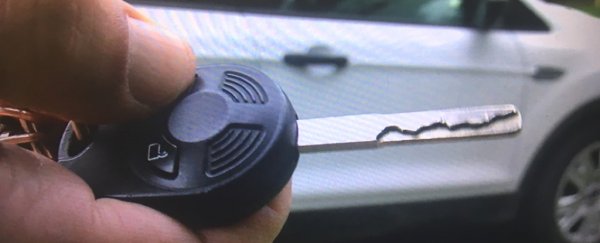A perplexing riddle affecting dozens of families in the Cleveland area has finally been solved, but not before weeks of wreaking havoc on people who – bizarre as it sounds – were unable to open their car and garage doors.
In late April, residents of the town of North Olmsted, Ohio began finding that their wireless car key fobs and garage door openers had simply ceased to function, or worked unpredictably when they did work at all.
Sometimes it would be one of a pair of remote key fobs that wouldn't work, while the other one did. At other times, car doors could be opened wirelessly when parked in other places, but if the vehicle returned to North Olmsted, the locked doors became inert once more.
One resident, Cory Branchick, assumed her key's battery must be at fault, so she replaced it only to find the problem hadn't been fixed at all – at least when she was parked in her driveway, that is.
"Anywhere else, when I go to work or when I go to the grocery store, the key fob works," Branchick told local WKYC news.
While dozens of neighbours across multiple nearby streets all reported the same phenomenon, nobody knew what was causing the widespread malfunction.
Some suggested it might be related to goings on at Cleveland Hopkins International Airport, or even a technological hazard related to a NASA research centre in the area.
Others, including city officials, suggested the malfunction might be related to telecommunications and electricity providers, who dispatched their own crews to investigate whatever could be jamming the residents' radio transmitters.
"It can't be some small device that's causing this interference," said North Olmsted City Councilman Chris Glassburn last week.
"We really thought it was going to be the utilities."
Despite those early suspicions, an intensive door-to-door investigation led by local authorities determined it was indeed just one rogue device behind the town's radio transmitters going dark.
The culprit, it turns out, was a home-made device invented by a local electronics enthusiast. He'd designed a specialised gadget to inform him if anybody was upstairs in his house while he was working downstairs in the basement.
"He has a fascination with electronics," Glassburn said in a statement describing the anonymous local inventor – an individual with special needs who had no idea of the harm he was causing in the wider community, simply due to the radio frequency his gadget continuously operated on.
"The way he designed it, it was persistently putting out a 315 megahertz signal. There was no malicious intent of the device."
That constant broadcast effectively jammed the radio signal for radio devices installed in car doors and garage doors, which frequently operate in the 315MHz to 433MHz radio band.
It's a bit scary to think that just one homespun radio device can so easily cause widespread outages in neighbouring technological gear – but for the people of North Olmsted at least, life for now can finally return to normal.
The home-invented gadget has now been identified and disabled, Glassburn said, adding there will be no further interference generated by it.
"And the resident has agreed to not make such devices in the future," Glassburn added.
